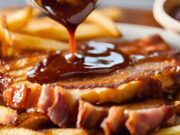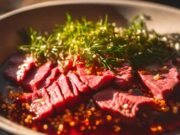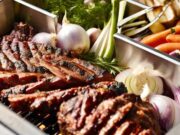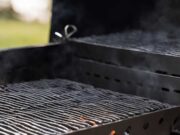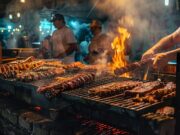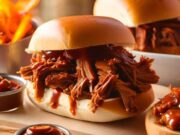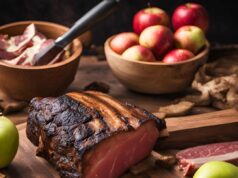If you have ever envisioned savoring a perfectly tender, smoky piece of barbecue, mastering indirect heat grilling is your key to achieving exceptional flavor.
This technique enables low and slow cooking, ensuring that your meats are infused with rich flavors while remaining succulent and juicy.
You will gain comprehensive knowledge on setting up your grill, selecting the appropriate foods, and avoiding common pitfalls.
Prepare to elevate your BBQ skills and impress your friends with mouthwatering results.
Key Takeaways:
- Indirect heat grilling involves cooking at lower temperatures for longer periods of time, resulting in tender and flavorful BBQ.
- Proper ventilation is crucial when setting up your grill for indirect heat cooking to ensure optimal heat control and even cooking.
- Use a meat thermometer and avoid common mistakes like opening the grill too often to achieve perfect, tender BBQ every time.
Indirect Heat Grilling: Low and Slow Techniques for Tender BBQ
Indirect heat grilling is a method that enables you to cook meat slowly and at lower temperatures, resulting in tender and flavorful BBQ dishes such as beef brisket and pork shoulder.
By utilizing equipment like a pellet smoker or charcoal grill, you can create an optimal environment for indirect heat cooking. This involves maintaining a stable grill temperature and allowing the meat to absorb smoky flavors over time.
This technique not only enhances moisture retention but also promotes the formation of a savory bark, making your BBQ dishes both irresistible and succulent.

Understanding Indirect Heat Grilling
Understanding indirect heat grilling is essential for achieving perfectly cooked BBQ dishes that are tender and full of flavor.
This technique involves positioning the food away from direct flames, allowing a gentler heat source to envelop the food and cook it low and slow. By utilizing this method, you can infuse rich flavors into your dishes as the smoke circulates around the meat and vegetables.
Indirect heat grilling is particularly effective for larger cuts of meat, such as briskets or ribs, as it promotes a gradual cooking process that enhances tenderness.
Moreover, it aids in moisture retention, ensuring that the final product remains succulent and delicious, whether you are using a gas, charcoal, or pellet grill.
What is Indirect Heat Grilling?
Indirect heat grilling is a technique in which food is cooked using the heat generated from the grill, without being placed directly over the flame. This method provides a more controlled cooking environment, making it ideal for tenderizing tougher cuts of meat while infusing them with rich, smoky flavors.
In contrast to direct grilling, where food is subjected to intense, immediate heat, indirect grilling involves positioning the food to the side of the heat source. This approach utilizes a barrier that traps heat and circulates it around the food, ensuring even cooking.
Popular equipment for this cooking style includes charcoal grills, which can be configured for indirect cooking by arranging the coals to one side, as well as pellet smokers that provide consistent temperatures for low and slow cooking. Collectively, these tools create an excellent environment for achieving perfectly smoked ribs or juicy brisket, making indirect heat grilling a preferred choice among barbecue enthusiasts.
Benefits of Low and Slow Cooking Techniques
Low and slow cooking techniques offer numerous advantages that can significantly enhance your BBQ dishes, resulting in tender, juicy, and flavorful meats.
This approach allows the connective tissues in tougher cuts, such as brisket and pork shoulder, to break down gradually, leading to exceptional tenderness that melts in your mouth. The extended cooking time promotes moisture retention, ensuring that each bite remains succulent, even after hours on the grill.
Furthermore, the temperature control characteristic of low and slow cooking enables rich and complex flavor profiles to develop, as spices and marinades penetrate deeply into the meat. This harmonious combination of tenderness, moisture, and flavor elevates the overall BBQ experience, making every gathering an unforgettable culinary celebration.
Preparing Your Grill for Indirect Heat
Preparing your grill for indirect heat cooking is essential for achieving optimal results. This process requires specific setup techniques to ensure even cooking and effective flavor infusion.
How to Set Up Your Grill for Indirect Heat
Setting up your grill for indirect heat involves strategically arranging charcoal or utilizing a pellet smoker to create zones that promote even cooking without direct exposure to the flame.
This method is particularly advantageous for larger cuts of meat, as it aids in achieving a tender texture while preventing the exterior from charring too quickly. When using a charcoal grill, it is advisable to pile the coals to one side, establishing a hot zone for searing and a cooler side for cooking through indirect heat.
In the case of a pellet smoker, the process is more straightforward; simply set the desired temperature and position the meat in an area that is not directly exposed to the heating element.
Understanding how to utilize these setups effectively will greatly enhance your grilling and smoking skills, ultimately leading to more enjoyable and delicious results.
Venting Techniques for Optimal Heat Control
Mastering venting techniques is essential for controlling grill temperature and ensuring consistent indirect heat throughout the cooking process.
Understanding how air circulation impacts cooking can greatly enhance your grilling experience. If you are using charcoal grills, adjusting the top and bottom vents is crucial; opening them increases airflow, raising the temperature, while partially closing them helps to lower it for slow cooking.
In contrast, pellet smokers rely on automated systems, but being aware of when to adjust the exhaust vent can be advantageous, particularly when aiming for a specific smoke flavor profile or managing temperature fluctuations.
Always monitor your grill’s internal thermometer and make gradual adjustments to achieve the perfect balance for optimal heat control.
Low and Slow Cooking Techniques
Employing effective low and slow cooking techniques is essential for achieving the ideal BBQ outcome, which is marked by tender meat and rich flavors.
Choosing the Right Food for Indirect Heat Cooking
Choosing the right food for indirect heat cooking is crucial for achieving optimal results, especially when dealing with tougher cuts such as beef brisket and pork shoulder.
These cuts are typically marbled with fat and connective tissue, making them ideal candidates for long, slow cooking methods that break down their fibers, resulting in tender and flavorful meat. By employing indirect heat, the cooking process ensures even temperature distribution, enhancing the natural flavors and textures of the meat.
Tougher cuts often exhibit a more pronounced beefy or porky flavor that develops beautifully over time. Optimal cooking times can range from several hours to an entire day, depending on the cut and size, allowing for a depth of flavor that is difficult to achieve with quicker cooking methods.
Ideal Temperature Ranges for Low and Slow BBQ
When cooking low and slow, it is essential to maintain ideal temperature ranges to achieve tender and flavorful BBQ that melts in your mouth.
Typically, these temperatures range from 225°F to 275°F, striking the perfect balance between heat and time. Cooking within this range allows the collagen in tougher cuts of meat to break down gradually, resulting in a juicy and succulent texture that enhances the overall flavor profile. These low temperatures also allow smoke to permeate the meat, enriching it with complex, smoky notes.
To ensure that these temperatures are consistently maintained, a digital thermometer is an invaluable tool. It provides precise readings that help you avoid overcooking or undercooking, enabling you to attain that perfect BBQ every time.
How Long Does Low and Slow Cooking Take?
The cooking time for low and slow BBQ can vary significantly based on the cut of meat, size, and desired doneness. For instance, cuts like pork butt and beef brisket typically require several hours to cook properly.
Factors such as cooking temperature, ideally maintained between 225°F to 275°F, greatly influence the total time needed for the meat to become tender and flavorful. Larger cuts, such as a whole brisket or a sizable pork shoulder, may take upwards of 14 hours or more to achieve that melt-in-your-mouth perfection, while smaller cuts will generally require significantly less time.
It’s essential to consider that temperature fluctuations can occur during the cooking process, particularly when using a traditional smoker. These fluctuations can add both time and variability to the final outcome. Therefore, monitoring the internal temperature closely is crucial to consistently achieving the desired doneness.
Cooking Tips for Perfect Tender BBQ
To achieve perfectly tender BBQ, it is essential for you to employ effective cooking tips and techniques, including the use of a meat thermometer. This will ensure both food safety and optimal results.
Using a Meat Thermometer Effectively
Using a meat thermometer effectively is essential for accurately gauging food temperature, ensuring your BBQ is cooked to perfection without the risk of overcooking or drying out.
Investing time in understanding the ideal internal temperatures for various types of meat will not only enhance your culinary skills but also maintain crucial food safety standards. For instance, when measuring the temperature of poultry, it is advisable to insert the probe into the thickest part of the breast or thigh, avoiding any contact with bone, as this can result in a falsely high reading.
Similarly, for beef cuts such as steaks or roasts, the thermometer should be positioned in the thickest section, typically the center, to ensure that the entire cut reaches a safe temperature. Familiarizing yourself with these best practices can significantly elevate your BBQ experience while ensuring that every bite is both tender and safe to enjoy.
Common Mistakes to Avoid in Low and Slow Cooking
Avoiding common mistakes in low and slow cooking can significantly enhance your BBQ experience, transforming it from potentially disappointing to truly mouthwatering.
Many enthusiasts often underestimate the importance of maintaining the right temperature throughout the cooking process. Fluctuating temperatures can easily lead to uneven cooking, resulting in parts of the meat being either overcooked or undercooked.
Inadequate meat placement can also cause various sections of the cut to receive different levels of heat exposure, ultimately affecting flavor and tenderness. To navigate these challenges effectively, it is essential to invest in a reliable thermometer for monitoring internal temperatures and a high-quality smoker that can maintain a consistent heat.
By placing thicker cuts closer to the heat source, you can ensure they cook evenly, leading to a delectably tender finish.
Final Thoughts on Indirect Heat Grilling
Final thoughts on indirect heat grilling highlight the importance of comprehending the techniques and methods that play a crucial role in producing flavorful and tender BBQ dishes. By mastering these skills, you can significantly enhance your grilling experience and achieve superior results.
Additional Resources for BBQ Enthusiasts
For BBQ enthusiasts aiming to enhance their knowledge and improve their grilling skills, a wealth of additional resources is available for exploration.
Books such as “The Barbecue Bible” by Steven Raichlen and “Franklin Barbecue: A Meat-Smoking Manifesto” by Aaron Franklin provide in-depth techniques and recipes that are designed to elevate both novice and seasoned grillers. Websites like AmazingRibs.com serve as excellent platforms for insights on various grilling methods, while dedicated YouTube channels offer visual guides and tips to inspire creativity.
Engaging with these materials promotes continuous learning and encourages experimentation, both of which are essential for mastering the nuances of flavor and technique. Each grilling session represents an opportunity to refine your skills while discovering new favorite recipes.
Frequently Asked Questions
What is indirect heat grilling and how does it differ from direct heat grilling?
Indirect heat grilling is a cooking technique where food is placed on the grill away from the heat source, while direct heat grilling involves cooking food directly over the heat source. This allows for slower and more controlled cooking, resulting in tender and juicy BBQ.
What are some examples of low and slow cooking techniques for indirect heat grilling?
Some common low and slow techniques include smoking, using a BBQ pit or smoker, and using a grill with an indirect heat zone. These methods allow for a longer cooking time at a lower temperature, resulting in tender and flavorful BBQ.
Why is indirect heat grilling ideal for tougher cuts of meat?
Indirect heat grilling allows for a longer cooking time at a lower temperature, which is perfect for breaking down tough muscle fibers in meats like brisket or ribs. This results in a tender and flavorful BBQ that falls off the bone.
Can I still achieve a crispy exterior on my BBQ when using indirect heat grilling?
Yes, you can still achieve a crispy exterior by using a technique called reverse searing. This involves cooking the meat at a low temperature on indirect heat, and then finishing it off with a quick sear over direct heat. This method results in both a tender and crispy exterior.
Do I need any special equipment for indirect heat grilling?
While some BBQ enthusiasts prefer to use a BBQ pit or smoker for indirect heat grilling, you can also achieve it with a regular grill by creating an indirect heat zone. This can be done by placing the coals on one side of the grill and cooking the food on the other side.
What are some tips for maintaining a consistent temperature when using indirect heat grilling?
To maintain a steady temperature, it’s important to have a reliable thermometer to monitor the grill’s internal temperature. You can also adjust the air vents on the grill to control the amount of oxygen and regulate the heat. Additionally, avoid frequently opening the grill lid, as this can cause fluctuations in temperature.








